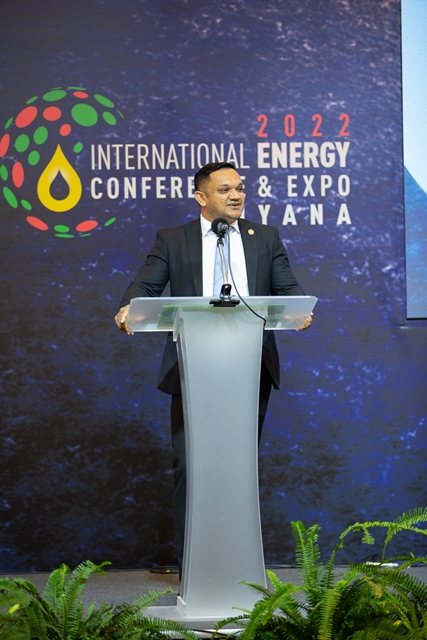In his debut address to the International Energy Conference and Expo-Guyana’s largest energy expo ever-Minister of Natural Resources, Vickram Bharrat expressed confidence about Guyana’s ability to become the energy capital of the region.
Such an ambitious goal will become a reality, the minister pointed out, when the natural gas from the prolific Stabroek Block is brought to shore through the government’s highly-anticipated gas-to-energy project. Already, the project is in advanced stages with geophysical, geotechnical, environmental and light detection and ranging (LIDAR) studies being conducted by ExxonMobil – operator of the Stabroek Block and the oil giant partnering to bring the gas to shore.
“Gas-to-energy is transformative and it will benefit every single Guyanese. It will not just lower citizens’ electricity bills, but it will build a vibrant manufacturing sector, thereby creating jobs. With manufacturing you get cheaper goods and services,” the minister highlighted.
The energy corridor of Guyana, Suriname and northern Brazil, will see countries teaming up to share power based on a collective understanding of their needs and their ability to supply.
On this initiative, the minister shared that talks with Suriname and Brazil are ongoing and that the countries are now in the drafting stages of developing a strategy that will work for the three countries.
The operationalisation of this plan will require development of local knowledge and capacity in the area of logistics and other technical support. With Guyana being a critical gateway between South America and the Caribbean, the links created by this corridor will position the country as a critical shipping hub.
“Guyana and Suriname are also looking at joint gas strategies and it will see growth for both frontiers. It must be noted, that in addition to the domestic demand of the two countries, there is also access to huge marketers in northern Brazil and the Guyana shield. As such, Guyana and Suriname have the potential of becoming the food and energy capital of the region,” Minister Bharrat said.
Furthermore, the natural resources minister stated that Guyana and Suriname are looking to establish a common gas strategy, which will also facilitate development in sectors such as infrastructure, industries and manufacturing and natural resources. Hence, both of the CARICOM nations will foster a local content platform that will create and support opportunities in not just the oil and gas sector, but other areas of the countries’ economies.
Recent hydrocarbon discoveries in the Guyana-Suriname basin include significant gas reserves that have renewed interest in the corridor. Guyana intends to pipe gas to shore from the Liza field to substitute its current oil-fired power generation. The Liza field was the first significant oil find offshore Guyana.
The government is also operationalising plans for renewable energy projects to support its intention of creating a cleaner energy mix. The energy corridor would see the countries teaming-up to share power based on a collective understanding of their needs and ability to supply. President Ali had said that the operationalisation of this plan would require development of local knowledge and capacity in the area of logistics.
The project had been under discussion for several years, as the Inter-American Development Bank (IDB) conducted baseline and pre-feasibility studies in 2016 and 2017 on what it calls the ‘Arco Norte Electrical Interconnection.’
The bank had stated that the main benefits of such a project would include lower-cost generation for all countries involved; potentially lowered electricity prices for consumers in Guyana and Suriname; more secure supply and reduced carbon dioxide emissions.







